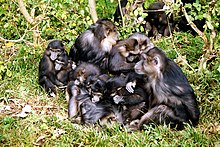Lore Lindu National Park
| Lore Lindu National Park | |
|---|---|
Ministry of Environment and Forestry |
Lore Lindu National Park is a protected area of forest on the Indonesian island of Sulawesi, in the province of Central Sulawesi. The Indonesian national park is 2,180 km2[1] covering both lowland and montane forests (200 to 2,610 meters above mean sea level). It provides habitat to numerous rare species, including 77 bird species endemic to Sulawesi.[3] The national park is designated as part of the UNESCO World Network of Biosphere Reserves. In addition to its rich wildlife, the park also contains megaliths dating from before 1300 AD.[4]
The easiest access to visit the national park is from Palu to Kamarora (50 kilometers in 2.5 hours drive). Due to up to 4,000 mm of rainfall per year in the southern part of the national park, the best time to visit is from July to September.[5]
Geography and climate
The boundaries of the park are defined by the Palolo Valley to the north, Napu Valley to the east and Bada Valley to the south. The western boundary is formed by a series of narrow valleys, known collectively as the Kulawi Valley. The Palolo, Napu, Lindu and Besoa valleys were once lakes, now partially filled with sediment. Lake Lindu (Danau Lindu) is the only large lake remaining today. The altitude ranges from 200 to 2,500 m above sea-level.[6]
The climate is tropical with high humidity. Temperatures vary only a few degrees over the course of the year, between 26 °C–32 °C in lowland areas. The temperature drops in the highland areas about 6 °C (11 °F) with every 1,100 metres (3,600 ft) rise in altitude. The heaviest rain period occurs during the monsoon which lasts from November to April.[6]
Flora and fauna

Lore Lindu National Park stretches over multiple ecosystem types, including lowland tropical forest, sub-montane forest, montane forest, as well as sub-alpine forest at altitudes over 2,000 metres (6,600 ft).[1]
Plant species include
Endemic Sulawesi mammals found in the national park include the
Megaliths

There are over 400 granite megaliths in the area, of which about 30 represent human forms. They vary in size from a few centimetres to ca.4.5 metres (15 ft). The original purpose of the megaliths is unknown.[8] Other megaliths in the area are large stone pots (Kalamba) accompanied by stone lids (Tutu'na). The megaliths are spread over the Napu, Behoa (Pokekea Megalithic Site) and Bada valleys.[9] Various archaeological studies have dated the carvings from between 3000 BC to 1300 AD.[4]
Human habitation

Surrounding the park there are 117 villages, from which 62 are located on the borders of the park and one is within the park. The local population belongs to the Kaili, Kulavi and Lore ethnic groups. There are also immigrants from South Sulawesi, Java and Bali.[6]
Conservation and threats
Lore Lindu has been declared a
Deforestation as result of illegal logging and land encroachment for agricultural activities is one of the main threats to the park.[10] Management challenges include lack of awareness of the importance of forest preservation and lack of law enforcement.[11]
Since 2000, the Indonesian-German Collaborative Research Center "STORMA" (Stability of the Rainforest Margin in Indonesia) is intensively investigating Lore Lindu National Park and its buffer zone.[12] STORMA's analysis of the effect of environmental protection on the level of deforestation in the park, suggests a reduction of the deforestation rate of around 9% as result of the protected areas status of the park. This estimate was based on a methodology involving propensity score matching rather than the conventional satellite image comparison.[13]
Tourism
To boost tourism, the Lore Lindu National Park decided to develop access road, electricity, clean water and resorts for visitors who visit the breeding ground for Maleo birds
See also
References
- ^ a b c d e f Ministry of Forestry: Lore Lindu National Park Archived 23 September 2015 at the Wayback Machine, retrieved 9 October 2010
- ^ Forestry statistics of Indonesia 2007 Archived 22 July 2011 at the Wayback Machine, retrieved 11 October 2010
- ^ a b The Nature Conservancy: Lore Lindu National Park: Building Partnerships to Protect Sulawesi’s Unique Wildlife, retrieved 9 October 2010
- ^ a b Sangadji, Ruslan: C. Sulawesi's Lore Lindu park, home to biological wealth, The Jakarta Post, 5 June 2005 Archived 3 March 2016 at the Wayback Machine, retrieved 11 October 2010
- ^ "TAMAN NASIONAL LORE LINDU". Archived from the original on 2 August 2012. Retrieved 6 May 2012.
- ^ a b c d Rolex Lameanda: Central Sulawesi as the most exciting Tourist Destination, Suedostasienmagazin Archived 19 July 2011 at the Wayback Machine, retrieved 9 October 2010
- ^ Chia, O.C.K. and P.K.L. Ng (2006). The freshwater crabs of Sulawesi, with descriptions of two new genera and four new species (Crustacea: Decapoda: Brachyura: Parathelphusidae). Raffles Bulletin of Zoology 54: 381–428.
- ^ National Geographic: Explorer's Notebook: The Riddle of Indonesia's Ancient Statues, 12 December 2001, retrieved 9 October 2010
- ^ "TN Lore Lindu". 30 June 2013.
- ISBN 978-3-642-05617-8.
- ^ UNESCO: Lore Lindu Biosphere Reserve: Management and conservation challenges, retrieved 9 October 2010
- ^ Georg-August-University Goettingen: STORMA, retrieved 9 October 2010
- ^ Schwarze, Stefan et al.:Do National Parks reduce deforestation? The effectiveness of the Lore Lindu National Park, Indonesia, in STORMA Discussion Paper nr.30, 2009[permanent dead link]
- ^ "LoreLindu National Park Develops 2 Sites to Attract More Visitors". 31 August 2016.
